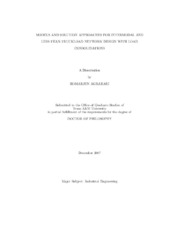| dc.description.abstract | Logistics and supply chain problems arising in the context of intermodal transportation and less-than-truckload (LTL) network design typically require commodities
to be consolidated and shipped via the most economical route to their destinations.
Traditionally, these problems have been modelled using network design or hub-and-
spoke approaches. In a network design problem, one is given the network and flow
requirements between the origin and destination pairs (commodities), and the objective is to route the flows over the network so as to minimize the sum of the fixed
charge incurred in using arcs and routing costs. However, there are possible benefits, due to economies-of-scale in transportation, that are not addressed in standard
network design models. On the other hand, hub location problems are motivated by
potential economies-of-scale in transportation costs when loads are consolidated and
shipped together over a completely connected hub network. However, in a hub location problem, the assignment of a node to a hub is independent of the commodities
originating at, or destined to, this node. Such an indiscriminate assignment may not
be suitable for all commodities originating at a particular node because of their different destinations. Problems arising in the area of LTL transportation, intermodal
transportation and package routing generally have characteristics such as economies-
of-scale in transportation costs in addition to the requirement of commodity-based
routing. Obviously, the existing network design and hub location-based models are not directly suitable for these applications. In this dissertation, we investigate the
development of models and solution algorithms for problems in the areas of LTL and
intermodal transportation as well as in the freight forwarders industry. We develop
models and solution methods to address strategic, tactical and operational level decision issues and show computational results. This research provides new insights
into these application areas and new solution methods therein. The solution algorithms developed here also contribute to the general area of discrete optimization,
particularly for problems with similar characteristics. | en |


